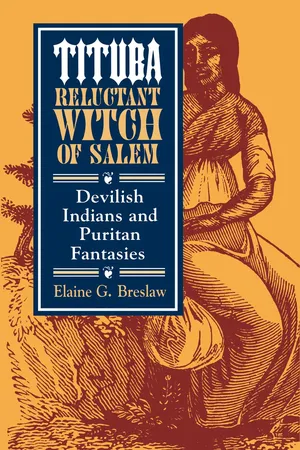![]()
Notes
NOTES TO THE INTRODUCTION
1. The elements of that hysteria and the details of the lives of both the accused and theaccusers are available in an extensive literature. See especially Paul Boyer and StephenNissenbaum, Salem Possessed: The Social Origins of Witchcraft (Cambridge: Harvard UniversityPress, 1974); Richard Godbeer, The Devil’s Dominion: Magic and Religion in Early New England (New York: Cambridge University Press, 1992); Larry Gragg, The Salem Witch Crises (NewYork: Praeger, 1992); Chadwick Hansen, Witchcraft at Salem (New York: George Braziller,1969); Christine Leigh Heyrman, Commerce and Culture: The Maritime Communities of Colonial Massachusetts, 1690-1750 (New York: W. W. Norton, 1984), 96-142; Carol F. Karlsen, TheDevil in the Shape of a Woman: Witchcraft in Colonial New England (New York: W. W. Norton,1987); George Kittredge, Witchcraft in Old and New England (1929 repr., New York: Russelland Russell, 1956); Lyle Koehler, A Search for Power: The “Weaker” Sex in Seventeenth-CenturyNew England (Chicago: University of Illinois Press, 1980), especially 169-75; David ThomasKonig, Law and Society in Puritan Massachusetts (Chapel Hill: University of North CarolinaPress, 1979), 158-85; Alan Krohn, Hysteria: The Elusive Neurosis (New York: InternationalUniversities Press, 1978), 163-66; Richard Weisman, Witchcraft, Magic and Religion in Seven-teenth-Century Massachusetts (Amherst: University of Massachusetts Press, 1984).
For a review of the literature on Salem witchcraft see David D. Hall, “Witchcraft and the Limits of Interpretation,” NEQ, 58 (June 1985), 253-81. The most complete collection of primary source material on those events is Paul Boyer and Stephen Nissenbaum, eds., Salem Village Papers: Verbatim Transcripts of the Legal Documents, 3 vols. (New York: Da Capo Press, 1977).
2. But see Chadwick Hansen, “The Metamorphosis of Tituba, or Why American Intellectuals Can’t Tell an Indian Witch from a Negro,” NEQ, 47 (March 1974), 3-12; and George Chever, “Prosecution of Philip English and His Wife for Witchcraft,” Historical Collections of the Essex Institute, 2 (i860), 73-85.
3. See for example Samuel G. Drake, Witchcraft Delusion in New England, 3 vols. (Rox-bury: W. E. Woodward, 1866), III:204; Charles W. Upham, Salem Witchcraft, 2 vols. (1867 repr., Williamstown, Mass.: Corner House Publishers, 1971), II:2-3, 27; Richard S. Dunn, Sugar and Slaves, The Rise of the Planter Class in the English West Indies, 1624-1713 (Chapel Hill: University of North Carolina Press, 1972), 337; Herbert Leventhal, In the Shadow of the Enlightenment: Occultism and Renaissance Science in Eighteenth-Century America (New York: New York University Press, 1976), 68-71; and Marilynn K. Roach, “ That Child, Betty Parris’: Elizabeth (Parris) Barron and the People in Her Life,” EIHC (January 1988), 124:6.
4. The more popular and fictional works that have helped to reinforce this view ofTituba’s role include Marion Starkey, Devil in Massachusetts, A Modern Inquiry into the SalemWitch Trials (New York: Alfred A. Knopf, 1949) and The Visionary Girls: Witchcraft in SalemVillage (Boston: Little, Brown, 1973); Arthur Miller, The Crucible (1952; repr., New York:Penguin Books, 1981); Shirley Jackson, Witchcraft at Salem Village (New York: RandomHouse, 1963); Ann Petry, Tituba of Salem Village (New York: Harper & Row, 1964); MaryEllen Kulkin, Her Way, Biographies of Women for Young People (Chicago: American LibraryAssociation, 1976), 284; William Carlos Williams, “Tituba’s Children,” in Many Loves andOther Plays: The Collected Plays of William Carlos Williams (New York: New Directions, 1961),226-40. The most recent fictional depiction of Tituba, Maryse Conde, /, Tituba, Black Witch of Barbados (Charlottesville: University Press of Virginia, 1092) is only loosely basedon the historic person. Conde uses Tituba as a metaphor for the twentieth-century African-American woman.
Bernard Rosenthal has been studying the elaboration of this myth of Tituba as an African in the literary imagination and scholarly studies. “Imagining the Puritan: Salem Story,” paper presented at Millersville State University, “Puritanism in Old and New England,” April 4-6, 1991, and his Salem Story: Reading the Witch Trials of 1692 (New York: Cambridge University Press, 1993), 21-31.
5. Of particular interest are the comments by Deodat Lawson, “A Brief and TrueNarrative of Witchcraft at Salem Village,” and John Hale, “A Modest Inquiry Into theNature of Witchcraft,” in NWC, 162 and 413. See also Robert Caleb, More Wonders of theInvisible World. . . . (London, 1700, 1796; repr. Boston, 1828), 225; SWP, 111:745-61.For a review of the evidence supporting an American Indian background see Hansen,”Metamorphosis.”
6. Upham, Salem, II:2. .
7. Drake, Witchcraft Delusion, 111:204.
8. NWC, 253nn.
9. Irving Rouse, “The Arawak,” in Handbook of South American Indians, ed. Julian H.Steward, 7 vols. (New York: Cooper Square Publishers, 1963), IV:507-46; E. G. Breslaw,” ’Price’s His Deposition’: Kidnapping Amerindian Slaves in Guyana, 1674,” JBMHS, 39(1991), 47-51.
10. BARD, RB3/10, 451. 455. See also Elaine G. Breslaw, “The Salem Witch from Barbados: In Search of Tituba’s Roots,” EIHC, 128 (1992), 217-38.
11. On this process of Greolization see Jerome S. Handler and Charlotte J. Frisbie, “Aspects of Slave life in Barbados: Music and Its Cultural Context,” CS, n (1972), 5-46 and Karl Watson, The Civilized Island of Barbados: A Social History, 1750-1816 (St. George, Barbados: Caribbean Graphic, 1979), 2, 41-42.
12. See in particular Jerome Handler “Amerindian Slave Population of Barbados in the Seventeenth and Early Eighteenth Centuries,” CS, 8 (1969), 38-64; and his “Amerindians and their Contribution to Barbadian Life in the Seventeenth Century,” JBMHS, 35 (1977), 189-210.
13. William P. Pierson, Black Yankees: The Development of an Afro-American Subculture in Eighteenth-Century New England (Amherst: University of Massachusetts Press, 1988) and Lorenzo, Johnston Greene, The Negro in Colonial New England (New York: Atheneum, 1971) have investigated the question of African influences but credit very little to those ethnic factors. Rather they stress the effect of English patterns on the non-white population.
14. See in particular Richard Slotkin, Regeneration Through Violence: The Mythology of the American Frontier, 1600-1860 (Middletown, Conn.: Wesleyan University Press, 1973), 116–45; Gary B. Nash, Red, White and Black: The Peoples of Early America, 2d ed. (Englewood Cliffs, N.J.: Prentice-Hall, 1982), 115-40; James Axtell, The European and the Indian: Essays in the Ethnohistory of Colonial North America (New York: Oxford University Press, 1981), particularly 272-315, “The Indian Impact on English Colonial Culture”...
